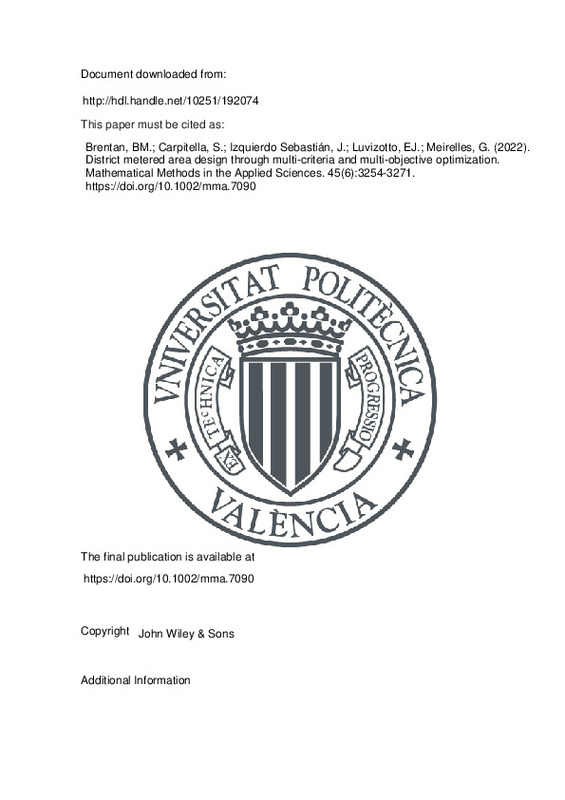JavaScript is disabled for your browser. Some features of this site may not work without it.
Buscar en RiuNet
Listar
Mi cuenta
Estadísticas
Ayuda RiuNet
Admin. UPV
District metered area design through multi-criteria and multi-objective optimization
Mostrar el registro sencillo del ítem
Ficheros en el ítem
| dc.contributor.author | Brentan, Bruno M.
|
es_ES |
| dc.contributor.author | Carpitella, Silvia
|
es_ES |
| dc.contributor.author | Izquierdo Sebastián, Joaquín
|
es_ES |
| dc.contributor.author | Luvizotto, Edevar, Jr.
|
es_ES |
| dc.contributor.author | Meirelles, Gustavo
|
es_ES |
| dc.date.accessioned | 2023-02-24T19:01:26Z | |
| dc.date.available | 2023-02-24T19:01:26Z | |
| dc.date.issued | 2022-04 | es_ES |
| dc.identifier.issn | 0170-4214 | es_ES |
| dc.identifier.uri | http://hdl.handle.net/10251/192074 | |
| dc.description.abstract | [EN] The design of district metered areas (DMA) in potable water supply systems is of paramount importance for water utilities to properly manage their systems. Concomitant to their main objective, namely, to deliver quality water to consumers, the benefits include leakage reduction and prompt reaction in cases of natural or malicious contamination events. Given the structure of a water distribution network (WDN), graph theory is the basis for DMA design, and clustering algorithms can be applied to perform the partitioning. However, such sectorization entails a number of network modifications (installing cut-off valves and metering and control devices) involving costs and operation changes, which have to be carefully studied and optimized. Given the complexity of WDNs, optimization is usually performed using metaheuristic algorithms. In turn, optimization may be single or multiple-objective. In this last case, a large number of solutions, frequently integrating the Pareto front, may be produced. The decision maker has eventually to choose one among them, what may be tough task. Multicriteria decision methods may be applied to support this last step of the decision-making process. In this paper, DMA design is addressed by (i) proposing a modified k-means algorithm for partitioning, (ii) using a multiobjective particle swarm optimization to suitably place partitioning devices, (iii) using fuzzy analytic hierarchy process (FAHP) to weight the four objective functions considered, and (iv) using technique for order of preference by similarity to ideal solution (TOPSIS) to rank the Pareto solutions to support the decision. This joint approach is applied in a case of a well-known WDN of the literature, and the results are discussed | es_ES |
| dc.language | Inglés | es_ES |
| dc.publisher | John Wiley & Sons | es_ES |
| dc.relation.ispartof | Mathematical Methods in the Applied Sciences | es_ES |
| dc.rights | Reserva de todos los derechos | es_ES |
| dc.subject | Decision making | es_ES |
| dc.subject | District metered areas | es_ES |
| dc.subject | Fuzzy AHP | es_ES |
| dc.subject | Graph theory | es_ES |
| dc.subject | K-means algorithm | es_ES |
| dc.subject | Metaheuristic | es_ES |
| dc.subject | Multiobjective optimization | es_ES |
| dc.subject | TOPSIS | es_ES |
| dc.subject | Water distribution systems | es_ES |
| dc.subject.classification | MATEMATICA APLICADA | es_ES |
| dc.title | District metered area design through multi-criteria and multi-objective optimization | es_ES |
| dc.type | Artículo | es_ES |
| dc.identifier.doi | 10.1002/mma.7090 | es_ES |
| dc.rights.accessRights | Abierto | es_ES |
| dc.contributor.affiliation | Universitat Politècnica de València. Escuela Técnica Superior de Ingenieros de Telecomunicación - Escola Tècnica Superior d'Enginyers de Telecomunicació | es_ES |
| dc.description.bibliographicCitation | Brentan, BM.; Carpitella, S.; Izquierdo Sebastián, J.; Luvizotto, EJ.; Meirelles, G. (2022). District metered area design through multi-criteria and multi-objective optimization. Mathematical Methods in the Applied Sciences. 45(6):3254-3271. https://doi.org/10.1002/mma.7090 | es_ES |
| dc.description.accrualMethod | S | es_ES |
| dc.relation.publisherversion | https://doi.org/10.1002/mma.7090 | es_ES |
| dc.description.upvformatpinicio | 3254 | es_ES |
| dc.description.upvformatpfin | 3271 | es_ES |
| dc.type.version | info:eu-repo/semantics/publishedVersion | es_ES |
| dc.description.volume | 45 | es_ES |
| dc.description.issue | 6 | es_ES |
| dc.relation.pasarela | S\421703 | es_ES |
| dc.subject.ods | 06.- Garantizar la disponibilidad y la gestión sostenible del agua y el saneamiento para todos | es_ES |







![[Cerrado]](/themes/UPV/images/candado.png)

